Hank's The Boss's Handbook
The BOSS’S
HANDBOOK
By
Harry Howell
DSc, MD (MA), PhD, Dr.Ac

CONTENTS
Introduction 1
Chapter 1 Securing a Positive Mental Attitude 19
Chapter 2 Building Self-Confidence 38
Chapter 3 Setting and Achieving Goals 60
Chapter 4 Building Relationships and Creating Rapport 100
Chapter 5 Eliminating Fears and Phobias 150
Chapter 6 Securing a Positive Mental Attitude 180
Chapter 7 Achieving Peak Performance When You Need it Most 220
Chapter 8 Adding Dynamic New Tools to Your Armoury 260
Chapter 9 Decision-making, and How to Get it Right Every Time! 310
INTRODUCTION
We are all inventors, each sailing out on a voyage of discovery, guided each by a guided chart, of which there is no duplicate. The world is all gates, all opportunities.
(Ralph Waldo Emerson)
Are you a good boss? A nice boss? A hard boss? A considerate boss? A mean boss? A fair boss? A demanding boss? A ruthless boss? Well, it doesn’t really matter because this book is not sitting in judgement on you. In fact, if you’re a really satisfied boss and don’t face any difficulties you can’t handle, then you probably don’t need this book.
But, if you’re a boss who has problem piled on problem, a staff not entirely on your side, you have moments of doubt and low confidence, are running short of people to blame, don’t trust others enough to delegate, then maybe this book is going to be YOUR SAVIOUR!
If you are becoming jaded, are beginning to underperform, are losing the trust of your employees, are failing to see the ‘bigger picture’, sometimes feel that hope is fading fast, have lost your grip on changing circumstances, lack the motivation you used to have … then you DEFINITELY need this book.
Have you ever sat quietly, in the office or at home, and thought about your values, principles, objectives in life? Do you have a mission, or do you just go from week to week hoping things will turn out well? Do you know how to go ‘inside yourself’ to seek an answer? Are you aware that there are parts of you that agree and other parts that disagree with every decision you make? Did you know that reaching these different parts can be learned quite simply? And this easy process can transform your life?
Are you an old-style boss, increasingly getting out of touch, feeling stale, even bored? Or are you a new boss, recently promoted, feeling a little out of your depth, not entirely sure how to proceed, lacking in adequate training for your new position, not too good at man-management – or should that be person-management? Is the business/company solely in your hands or do you share responsibility? Is it a roaring success, or slowly going down the drain? Do you still find time for a good family life, or is that suffering too?
Success doesn’t necessarily come easily. Many highly successful people struggled hard to achieve it:
· Albert Einstein couldn’t speak until he was four and couldn’t read until eleven. His teachers labelled him slow and mentally handicapped
· Thomas Edison was told by his teachers he was too stupid to learn anything. And he created 1,000 light bulbs before he found one that worked … he just never recognised failure
· Elvis Presley’s manager – at Nashville’s Grand Ole Opry – told him he couldn’t make a living from singing and he should go back to his old job, driving a truck
· Walt Disney was fired from his job because he ‘lacked ambition and had no good ideas’
· Vincent van Gogh sold only one picture in the whole of his lifetime … and that to a friend!
· J K Rowling was fired as a secretary, was divorced and raising a daughter alone … and had more than 100 rejections for her first Harry Potter book. Now, less than 15 years later, she is the first person ever to make a billion pounds from writing, is one of the richest people in the UK, and is richer than the Queen!
· Oprah Winfrey was told she was unfit for TV news!
The list is endless. People who believed in themselves, shrugged off rejection and strode bravely on. They had a vision, an objective, a mission, and nothing was going to stop them achieving it. They had belief because they had imagination … that magical quality that distinguishes us from the rest of the animal kingdom. In fact, we are often closer to the animal kingdom than we like to think.
For example, would you consider yourself demanding and aggressive – like a shrew?

Lots of positive qualities: high energy, very intelligent, know how to get what it wants, dynamic metabolism, very articulate … but possible burdened with an undeserved reputation as thrifty, self-absorbed, constantly whining …
Or maybe a gorilla? A strong, rough diamond individual with a powerful – if maybe a little coarse – exterior that skilfully conceals that inner softness that can occasionally be tapped into. Bursting with enthusiasm for new projects and a master at instilling that enthusiasm in others.

But there are weaknesses, too. Like a certain naivetié because they mainly take into account the benefits of the project without considering the downsides – believing they can always bulldoze their way through obstacles. And often they can!
A wolf, perhaps? Amazingly agile with abundant self-confidence, the wolf can take almost anything in its stride. Great communicators they are like an open book. They work extremely well in groups and don’t hesitate to demonstrate their emotions through their body language. They can be generous to a fault but while they are exceptionally communicative to their peers they demand unswerving loyalty and devotion from their underlings. Sometimes unappreciated in literature for their good points, this is often due to jealousy – particularly in romantic areas. Everyone watches the wolf carefully … the wrong move can spell disaster as quickly as all the right signs can bring success.

Some bosses are like porcupines. They have about as much attitude as a porcupine has
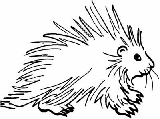
prickles. They are very opportunistic, quick to take advantage of any weakness or opening they see. They delight in putting others down through sarcasm and ridicule, probably because they don’t, themselves, have a very high self-esteem. Difficult to handle, they lack the tact and charm necessary to coax others to work with them. So they are best working alone, where they can take all the credit for what they do.
What kind of boss could be a mouse? Seems hardly credible, but they do exist. They are the ones who love to plan well ahead, gathering their resources and tucking them away for future use. Mice bosses are usually small, timid people who have quickly learned that they have to depend on themselves. They can be quite pernickety and like everything to be in its designated place.

Then there’s that well camouflaged boss, the crocodile. He deceives everybody, with his false tears and sympathy which he/she uses to take advantage of any weakness or, at the very least, to get you on his/her side. This boss lives on the seamier side of life, using cheap hotels, cafes rather than restaurants, and seedy night-spots rather than glossy night-clubs.

There is a boss who is seemingly remote, swathed in mystery because of their rare appearance. Whispers abound of their almost limitless grasp of situations and circumstances allowing their sudden swoop for the kill to add to their reputation. They are, of course, owls.

They sit, remote in their ivory towers, watching the world go by and opportunities developing that they can pounce on … but it is this remoteness that never allows them to connect with their staff, who can do little more than admire from a distance, and hope for a few scraps.
Some bosses just sweep through life depending on little more than their ability to bedazzle everyone with their beauty or good looks, their fine clothes, their flashy cars and elaborate

lifestyle. They are, of course, the peacocks.
They have small brains, underwhelming intelligence, and rely solely on their elegance and style to carry them through muddy waters and the chaos around them. Always a target for the paparazzi, they inevitably shine through most situations with calm and ease.
Unlike that cunning carnivore boss, the weasel. They have minds like computers, rapidly assessing every situation, able to create chaos around them that they alone can pick their

way through. Their body can move as quickly and resourcefully as their mind and they are quick to attack once they have found their opponent’s weakness. One of the weasel’s main tactics is manipulating others, but you underestimate them at your peril.
Chapter 1
Securing a Positive
Mental Attitude
Perhaps the first thing to recognise is that if one person can do it anyone can do it.
An example of this is in San Francisco, where they set up what they call the One Thousand Club. The members have all survived Aids, and the establishment of the club was to give encouragement to others who had the same condition.
The real point is that you don’t need 1000 survivors, because if only one person had survived it means that it is possible to survive Aids.
A few decades ago Roger Bannister broke the world record for the 4 Minute Mile, previously thought impossible. Since then it has been broken so many times that people are now talking about the 3½ minute mile. Will it ever be achieved? Maybe not in the next few months, but don’t bet against it.
Records, all kinds of records, are being broken all the time. When Guinness brought out their book of Records, they provided a reference guide for all ambitious people to aim for. So you get my point? Once one person has done something, they have proved it can be done. If someone sold 100 gold necklaces in one day, so can you. If someone walked on the moon, so can you! Sir Richard Branson and others are already planning craft that will ultimately make pleasure trips to the moon.
So to put this principle into the current context of what we are capable of doing for ourselves, we can always look to examples of other people who have achieved what we want to achieve. If they’ve done it, so can we. And why stop there? Why not go that little bit better!!!
The world has to have everything proved. It operates on the basis of trade. You accept my illusions and I’ll accept yours. Then someone has to go out and prove the illusion can also become reality. While the Las Vegas Valley in the state of Nevada might have been part of the old Spanish Trail due to its artesian wells, it took the imagination and determination of that infamous Mafia duo, Bugsy Spiegel and Meyer Lansky to turn it into the biggest entertainments mecca in the world.

Let’s examine the six main characteristics of a positive mental attitude.
1. Inner motivation. Here’s a secret, just between us. Most top achievers have two directions to go: away from or towards motivation. Look at boxing, for example. People like Mike Tyson turned to boxing not only because they want to achieve riches and fame (towards motivation) but also because they want to escape from the poverty they’d been born into and would continue to live in unless they could drag themselves out of (away from motivation). They vividly imagine specific undesirable consequences worth avoiding, and then very desirable and worthwhile goals that draw them forward. By doing this, they get the maximum motivation.
2. The value of high standards. We often read or hear about the obsession that many athletes, golfers, tennis players, footballers, etc. have to be the best. They know, better than anyone, that to be the best you not only have to work harder than anyone else, you also have to set the highest standard for yourself. Nothing below that is going to take you to the top. Of course, you might not want to reach the very top of your profession, you might just want to be doing better than you’re doing now. Even to achieve that means reviewing your present standards and raising them – giving yourself something to aim at.
3. Lumping down goals. If you just said to yourself, ‘I want to be the best in the world at … (whatever)’, the amount of effort required to achieve that might be too overwhelming. So you give up almost from the beginning. Isn’t that exactly what happens to most people who fail to achieve their ambition? The vast majority of us!!! But to lump down means to examine the overall requirements and to break it down into steps … or in Neurosynchrony terms, to take one lump at a time. First it enables you to focus on small tasks that you can actually achieve. Secondly, it gives you great satisfaction as you go along, because you know you are on the way, and the tasks you have set yourself might be difficult but they are within your grasp if you continue to make the effort. This helps you maintain your motivation.
4. Combining future and present time frames. Having set yourself a task it is essential to concentrate on achieving that task only. Any kind of distraction will become a discouragement, especially if you start thinking into the future. But, once having achieved that task, then you can project yourself into the future, focussing on that net lump towards your goal. This will help you maintain motivation.
5. Personal involvement. I like to think about planting lots of seeds. But a farmer can’t plant his seeds and then ignore them. He has to water them. That is your personal involvement. Perhaps you can take guidance from someone you look up to, but it’s what you do for yourself that is going to determine whether you succeed or fail I whatever task you set yourself.
6. Self-to-Self comparisons. This means learning to judge yourself and your progress. ‘How far have I progressed since yesterday? Or since last week or last month? Since last year?’ All of us can learn to do this, to measure our progress. But we need to be honest with ourselves and to judge ourselves with enthusiasm. After all, if we are making progress we have something to cheer about. And if we are not, we need to think hard about where we are falling down. We are all going to have failures along the way … that is part of life and part of learning to succeed. Remember this little gem: If what we’re doing doesn’t work, do something else or do it differently. That sounds logical enough but believe me, one of the main reasons that people fail in life is that they just keep on repeating their own failures. They have never learnt that the reason they’re failing is because they’re doing it wrong.
I prefer to think of failure as merely the opportunity to review what I’ve done and find a way of doing it differently in order to achieve the same goal.
Are you getting what you want?
When you look at your life, are you getting what you want? Or are you getting what you need in order to change? Do you want to change some area of your life and can’t seem able to do it? Perhaps you are unable to resolve an unhealthy relationship, or are unable to give up smoking? Or you are unable to become financially successful? Is additional finance going to give you all the things in life you want?
Every day we make choices. Many of the choices we make spring from an unconscious level. Sometimes we want to change and it seems that whatever we do, there is a subconscious genie sitting on our shoulder that continually causes us to sabotage all our efforts.
Let’s say a person consciously wants to get well but unconsciously seems to resist all treatment, perhaps even all help. Or a person wants to achieve promotion at work, yet everything they do seems to work against that and they continue to stay at the same level.
If that is the case, there is a good chance that that person is what we call Psychologically Contradicted (PC). That means that the inner resources, instead of helping us to achieve our goals, are somehow working against us – preventing us from succeeding. How many times have you set your mind on doing something only to find that no matter what efforts you make, you still don’t achieve your goal?
A person who is PC is probably very negative about almost everything and has a self-defeating behaviour and attitude. That person might be addicted to alcohol or drugs. Or simply cigarettes or coffee. Another person might have a debilitating disease.
There are many areas in which a person might be contradicted. One common area which applies to many people is difficulty in being intimate or in establishing a truly good relationship.
People with money problems will probably test weak for the assertion, ‘I want to be successful’. What do I mean by ‘testing weak’? A simple muscle test, which anyone can learn to do, and which will reveal untold answers to so many baffling questions.
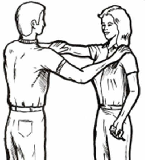
Get someone to stand facing you, placing one hand lightly on the wrist area of your outstretched arm and the other hand lightly on the opposite shoulder – as illustrated above. The object is for the person being tested – the testee – to resist any pressure on the arm as the person doing the testing – the testor – presses down. It isn’t a test of strength, merely a resistance to pressure. If the arm collapses against the pressure, we call that a weak muscle, or if it remains in position we call that a strong muscle.
This method of testing was discovered in 1960 by American chiropractor, Dr George Goodheart (whom I studied with in the 1970s). He called it Applied Kinesiology. He found that when he applied manual pressure to a muscle by slightly pressing down on it, if the related organ was not functioning normally the strength of the muscle would immediately weaken. He quickly saw how valuable this could be become as a diagnostic tool. It wouldn’t necessarily tell him what was wrong with an organ, only that something was not quite right.
Similarly, he found that where a malfunctioning organ led to a weak muscle, once that organ had been successfully treated the related muscle would go from weak to strong again. So it became a double-edged diagnostic/treatment tool.
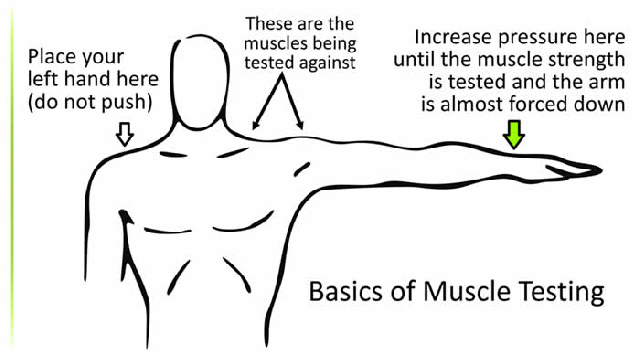
Further, he found that a weak muscle would respond to positive stimuli by strengthening even though the organ had not yet recovered. In other words, if you found a weak muscle and offered it the appropriate nutrition, homeopathy, herbal treatment, acupuncture etc., the muscle would react by strengthening in anticipation of the most efficacious treatment being given. To make it even clearer, the muscle would react positively only when it was offered the appropriate treatment. For example, if a person had scurvy, it would react positively when offered Vitamin C. If offered any other vitamin the muscle would remain weak. So the therapist still had the task of finding the appropriate treatment, and he would do this by offering various options and testing the muscle against each one until he found one that caused the muscle to strengthen. Then he would proceed to give that as a proper treatment. I guess you could call it empirical treatment.
Although trained in Applied Kinesiology from the 1970s, I wanted to go in different directions. The International College of Applied Kinesiology (ICAK) laid down very strict rules as to how AK could be used, which were at variance to how I wished to use muscle testing, so I didn’t have any choice if I wanted to continue developing muscle testing according to my own visions. First, my early training as a psychotherapist led me to want to explore abnormalities of the Mind, so I developed a technique that I called Psycho-Myoneurology (PMN). I realised that using organ-related muscles would not be appropriate, so I had to use the link between brain, muscles and nerves – from which I drew the name. To do this, I realised I could use any muscle, although in practice I would normally choose the deltoid because it is usually the most convenient. If a person was lying in a supine position (on their back) while testing I might use the deltoid (arm muscle) or the quadriceps (leg muscle), depending on where I was standing.
Please take this test seriously because during the course of this book I am going to show you how you can use it to determine a multitude of things. And you are going to see remarkable results from the testing and treating.
To return to Psychological Contradiction, if you – the testee – give the statement ‘I want to be rich’ while the testor is pressing down on your extended arm, your arm should stay strong, meaning you agree with the statement. Of course, you might not actually want to be rich, you might only wish to be wealthy, or financially secure, or whatever. You can substitute your preferred desire for ‘rich’ when being tested. But if your arm goes weak when being tested, it is saying you do not want to be rich – or whatever your choice is. In other words, you are psychologically contradicted.
Similarly, you could say, ‘I want to be successful’ while being tested. If your muscle goes weak it means psychologically contradicted. After all, no one in a healthy state of mind would want to be a failure. Relatively few would choose to be ‘poor’, although for social/ethical reasons some might prefer it.
Normal problems exist in degrees and people who toe the line between being psychologically contradicted (PCed) and not being PCed can slip into becoming PCed by being around other people who are PCed. Make sense? Hope so!
The answer to this is simple. In Chinese acupuncture, the point we want is
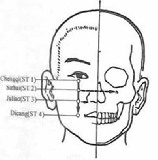
Stomach 1, which is on the bony ridge of the eye socket just below the centre of the eye, as illustrated above. If you tap it gently about 25 times while repeating ‘I want to be successful’ or ‘I want to be rich’, this will actually reverse the PC you have. Obviously, care has to be taken that you are tapping the ridge and not the eye itself. Perhaps it is advisable to get someone else – the testor – to do the tapping initially, and when completed to test the muscle against your original statement, ‘I want to be successful’ or whatever statement you made.
While it went weak before, if the contradiction has been corrected the muscle should now test strong.
Let me repeat these steps more simply:
· Test muscle – should be strong
· Make statement ‘I want to be successful’ or whatever you choose; test muscle – should be strong. If the muscle has gone weak, indicates you are Pyschologically Contradicted
· To correct, continue to make the same statement repeatedly while tapping Stomach 1 point 25 times
· Retest the muscle while making the same statement. If strong, means contradiction has now been corrected; if muscle still weak, repeat the statement while tapping Stomach another 25 times. Retest the muscle. Should be strong. If still weak (very rare) consult a specialist.
Belief Systems
Beliefs are very powerful. We fight wars over them. We build monuments to them. Medicine, psychology and political systems are built on them. But, unfortunately, sometimes they aren’t true. We just think they are. Sometimes we believe in fairy tales.
· ‘Heavier-than-air flying machines are impossible.’ (Lord Kelvin, President of the Royal Society)
· ‘Everything that can be invented has been invented.’ (Charles Duell, Director of U.S. Patents Office, 1899)
· ‘Sensible and responsible women do not want to vote.’ (Grosvenor Cleveland, 1905)
· ‘There is no likelihood man can ever tap the power of the atom.’ (Robert Milikan, Nobel Laureate in Physics, 1923)
· ‘Who the heck wants to hear actors talk?’ (Harry M. Warner, of Warner Bros Pictures, 1927)
Belief systems are difficult to change. Can a leopard really change its spots? That statement is often given to imply that if a leopard cannot change its spots, then nor can a person change his/her personality/behaviour. Yet the two things are not comparable. The leopard’s spots are a physical characteristic which clearly cannot be changed. Personality/behaviour are non-material characteristics that have been partly inherited and partly acquired. So clearly one is capable of change the other is not.
But life is not that simple. There are too many other mitigating circumstances. Not least of which is the amgydala, that part of the brain that deals with emotions. We tend to filter out information that does not coincide with our beliefs. We each live in a different world, and our individual world is largely shaped by our beliefs.
Have you noticed how difficult it is to get someone to change their when they don’t want to do so? The reason is almost certainly because they have a different belief system. So if you want to change them – which you cannot do, anyway (they can only change their self) – you first need to determine their belief system and offer them a choice within their system. It works on a similar basis to reverse psychology – giving someone the opposite to what they want by suggesting it is what they want.
Let’s do some exploring together.
What would happen if you walked around your house wearing a blindfold? The chances are that you’d find yourself bumping against furniture, walking into walls, probably tripping over things lying on the floor.
Despite these mishaps, you would still know which room you are in. you would have a good idea of the layout of the room, so could avoid some of the mishaps. In general, you would be able to navigate your way around the room without any real danger to yourself. It’s like you had a mental map of the inside of your house right there in your head. It has been established that even blind people – those who have never seen anything since birth – are able to form mental maps of where they live. Can even form mental maps of their immediate location, which is how they are able to go out shopping just with the aid of a stick.
Now, what would happen if I asked you to walk around my house with a blindfold on? A house you had never entered before. A completely new territory. You wouldn’t know which room you were in, where the door was, how furniture was laid out … and if you finally made it to the door – with a few bruises acquired along the way – you wouldn’t know where the next room was, or whatever.
You don’t have a map of my house inside your head so you would be completely lost. The chances are that you would try and use the head-map of your house, which would be totally different and of no use to you whatever.
Without us realising it, we all carry head-maps of just about everything we do in life. We have head-maps of where we go shopping, of the kind of music we like, the meals we like to eat, the kind of partner we want – tricky one that, because so many of us go on choosing the wrong partner time after time. More about that later.
There are two pieces of information that will help you in a million different ways, as you will see as we go through these pages. The first one is to determine whether you are left or right brain dominant.
I’m sure everyone reading this will already know that there are two sides to the brain, divided by the corpus callosum, which acts as an interface between the two sides. The left brain is responsible for all our logic and learned information, while the right side is responsible for our imagination and creativity, as listed in the diagram below.
If you want to discover which brain-dominant side you are, simply utilise the muscle test that we did earlier. Place the palm of your hand on the right side of your head and get someone to test your opposite arm muscle. Repeat the test, putting your palm on the left side of the brain while your colleague tests your arm muscle again. You will usually find that on one side the arm will remain strong while the arm muscle will go weaker when testing the other side of the brain. The side that remains strong is the dominant side. If both sides remain strong it indicates that both sides are fairly well balanced, neither side being dominant.
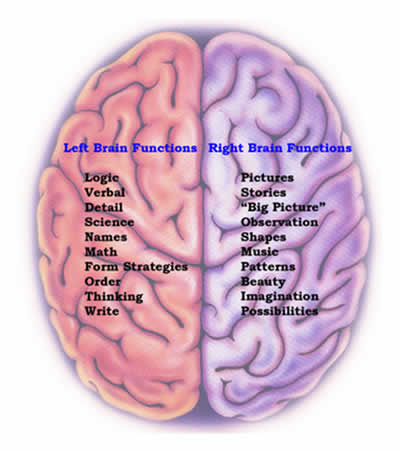
You can, of course, test this against what you know of yourself. If you prefer reading, maths, science, thinking, etc., you will already know you are left brain dominant. And if you prefer painting, music, pictures, creativity, you will confirm that you are right brain dominant.
This information can be helpful in guiding you through life. You would be better suited following a profession or career along the lines of your strengths rather than your weaknesses. It happens quite occasionally that people might question why they are doing the kind of work they are doing, which doesn’t feel quite right to them. A good example is my brother-in-law, who is a doctor who always wanted to be a painter (I got told off for once calling him an artist!).
If you listen carefully to the way people talk, you can usually get a very quick idea if they left or right brain dominant. Think about it. You are immediately in possession of vital information if you want to create a good rapport with them because you can coordinate the way in which you deal with them in a way they can identify with and appreciate. More about rapport later.
The other amazing information I want to give you is how to tell if a person is lying or telling the truth! I’ve already given you half the story. The left brain is logic – and where information is stored. The right brain is creative – or where you construct images.
Now it is a fact that if someone asks you a question you cannot give an answer without going to some part of the brain for the information you need to provide an answer. What you might not know is that the eyes move in the direction of the part of the brain you are going to for that information. Mostly, it is under the control of the Autonomic Nervous System (ANS) – in other words, you don’t consciously control it. The eyes automatically move.
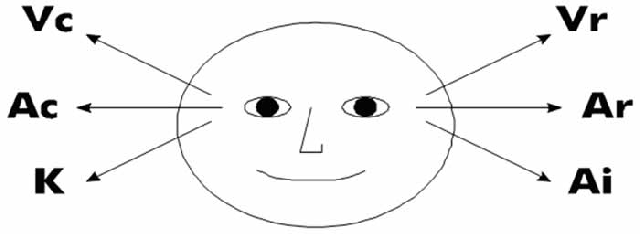
Let me quickly tell you a few more things about the eyes, and how they give us clues about ourselves. We have five senses, of which only three are highly developed in humans – smell and taste being the two minor senses except for those individuals who have trained those senses to be more acute. Our main senses are sight – vision –, hearing – auditory –, and touch – kinaesthetic.
Now let’s combine what we know about the two sides of the brain with what we know about our main senses. We can say that:
· If we look diagonally up to the left, we are contacting the part of the brain that deals directly with things we have seen – our visual images (Visual Remembered – VR)
· If we look horizontally to the left, we are contacting that part of the brain that stores things or sounds we have heard (Auditory Remembered – AR)
· If we look diagonally down to the left, we are contacting that part of the brain that deals with touch, which manifests itself in an Internal Dialogue – AR
· If we look up diagonally to the right we are contacting visual images that we are constructing – VC
· If we look horizontally to the right we are contacting dialogue we are imagining, or constructing – AC
· And if we look diagonally down to the right we are contacting our sense of touch – K
There are many ways in which we are going to be able to use this information of eye movements towards our success, but right now we are only concerned with using these eye movements in terms of being truthful or lying – or shall I temper that more delicately by saying ‘being creative’?
So, in a nutshell, if you ask someone a question and they immediately look left before answering, you know that they are trying to remember what took place. If, instead, they look right, you know they are probably inventing an answer. Sometimes, people will look left first and then immediately look right. Having failed to remember the answer – or, perhaps choosing not to reveal it – they then construct an answer that more suits their purpose. This method of observing if someone is telling the truth or not is not infallible, but it is a good clue, and one you can follow up by asking more questions if you think it necessary.
Now to return to our discussion on head maps. There are three points that need to be made:
1. No map is 100% accurate. No map can contain every single detail of even the most simple object. One could look at a rough diamond for a whole lifetime and not have all the answers to all the questions that could be asked about that unpolished stone – not yet a gem. You wouldn’t know exactly how it had been formed, how old it was, the various stages it had gone through to reach its present state, exactly what it would look like when it had been cut and polished, what its market value would be when completed, its value in 50 years. Who would own it, how would its owner regard it, would it later be sold, inherited, lost, stolen, destroyed … so many possibilities. It is the same with the head map of your own house. You know the rough layout of the rooms and the furniture in each room, but all that you know is only approximate. Do you know, for example, how many millimetres it is from the window to the door of your kitchen? The weight of the front door? The number of bricks used in the construction of the house? How accurate is your head map of your partner or your mother? Do you know exactly what they think of you? Do you know exactly what they think of each other? We like to think we have all the answers, but in reality all we have is a vagueness. And if we don’t know with 100% accuracy abut the things we think we know about, how accurate are our head maps of things we hardly know at all?
2. No two people’s head maps are the same. We might think we share a common interest with those close to us, but do we really? You and your best friend can both look at the same painting at the same time in the same place, and form totally different views. We might agree in general terms that we both like the picture but we will have observed it from different perspectives. One might like the textures while the other prefers the colours. One might like the subject matter the other might not. You and your best friend are watching a singer perform, but you form different head maps of her. One might be enthralled by her voice, the other by her beauty. One might rave about her choice of song, the other concentrating on her style of dress. The simple truth is, we all have a different and unique head map of everything we encounter, otherwise we would all be thinking exactly the same things in the same way – which obviously we don’t.
3. Most importantly, we instinctively react to our head map rather than to the reality. If we don’t like something which confronts us, we shy away from it – usually because we have a preformed concept – our head map – of whether like something or not. It could be a style of music or clothing, a political party, a particular religion … or whatever. We have a head map for everything we have encountered, and that is what guides us through our lives.
However, although our head maps are sufficiently accurate to satisfy our needs, many people have head maps that are so inaccurate that they can’t get through life without help in order to survive. Some people need strong medication to help them struggle against their inaccurate head maps, others have to be hospitalised.
Head maps are not indelibly stamped. They can be modified as we go through life and absorb new experiences; they can be distorted, magnified to obsessive proportions, or diminished almost to obscurity or unimportance. They can be deleted and replaced by a new head map, for example when you move house, change job, get married or divorced, change religion, change your taste in music or clothes or football club support, etc.
Unfortunately, many of us become lazy when we form new head maps. We draw them with insufficient evidence, we allow red herrings to slip into their design, they can sometimes include false beliefs, may be drawn in black and white without any shades of grey, can apply labels to things and people without seeing beyond the label.
In other words, they can be horribly inaccurate. An accurate head map gets us through life with much greater ease and happiness. Inaccurate head maps lead us into territories we would be better avoiding. It can take time and a great deal of effort to construct an accurate head map, and it will always be incomplete because there is not enough time in our life to be completely accurate.
If we want to aspire to greater accuracy in our head maps here are a few tips we can use:
1. Remember that nothing is pure black or pure white … there are many shades in between. ‘Nothing is good or bad, but thinking makes it so,’ (to borrow from Shakespeare). Perhaps we can review and modify some of our strongly held convictions; our earlier convictions might be no longer appropriate. We can quickly learn that all things vary by degree.
2. Recognise that because we have always held a certain belief doesn’t make it true. I went through nearly half my life misspelling the word ‘separate’ until someone pointed it out to me. Since then I am able to spell it correctly. I know there are many things I do that are incorrect, though I don’t necessarily know what they are. But when I come across them and I take a moment to think about them, I am able to make some improvement. A missile doesn’t head straight for its target: it heads in the general direction and constantly makes corrections in its flight path. And that is what we need to do in our lives.
3. No two things in life are identical. Two grains of rice might look identical at a glance but put them under a microscope and you will see incredible differences. It doesn’t matter that they are different so long as we don’t fool ourselves into thinking that the labels we give things – or people – mean they’re the same thing. One Englishman is not the same as any other Englishman just because they are both English.
4. The world we live in is constantly changing. The head map of our living room needs modifying when we switch the furniture around. We mustn’t be afraid or even reluctant to review our head maps and make changes when they are needed.
5. Recognise that nothing in the world lives in isolation. Life is a constant round of action, interaction and reaction. Change the circumstances and we might react completely differently to previous reactions. But don’t react for the sake of it.
Tags:
1 user(s) like this







